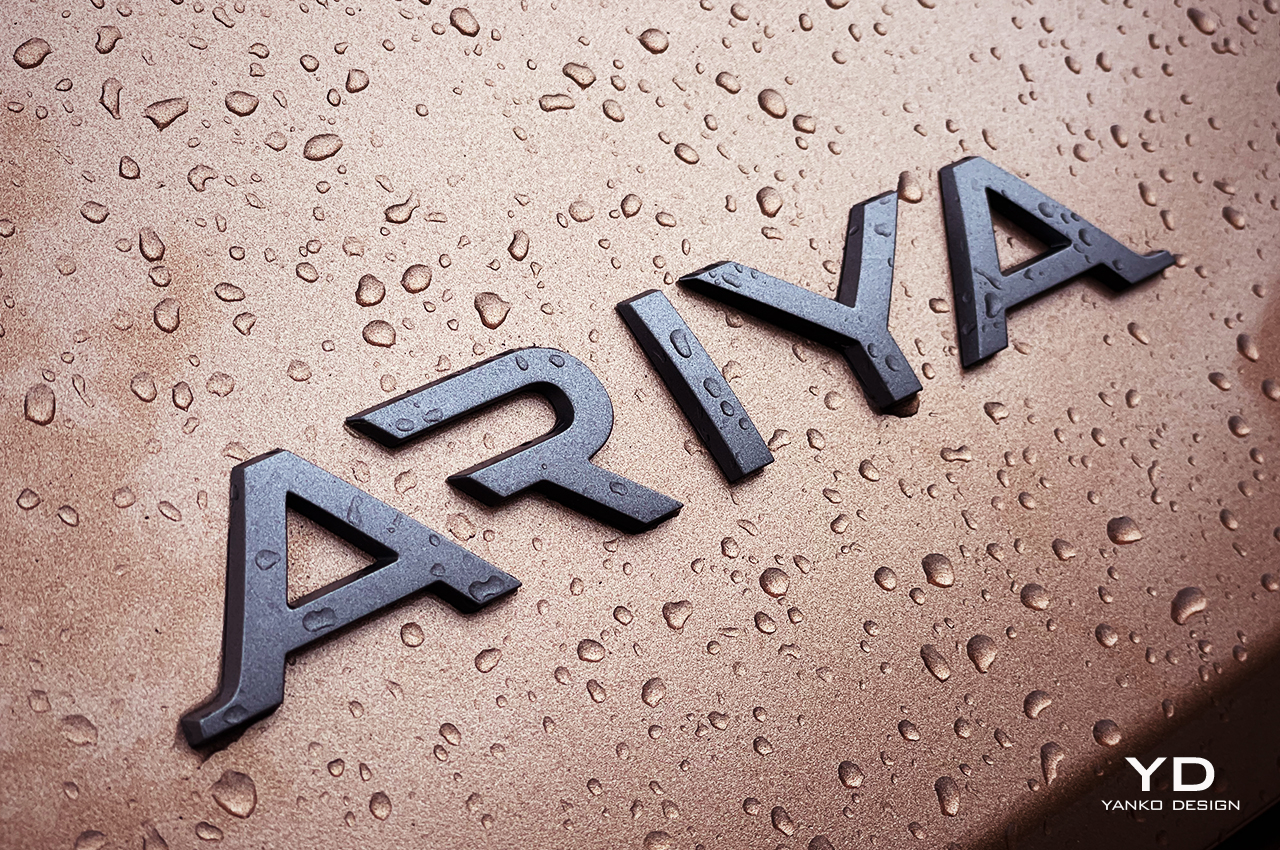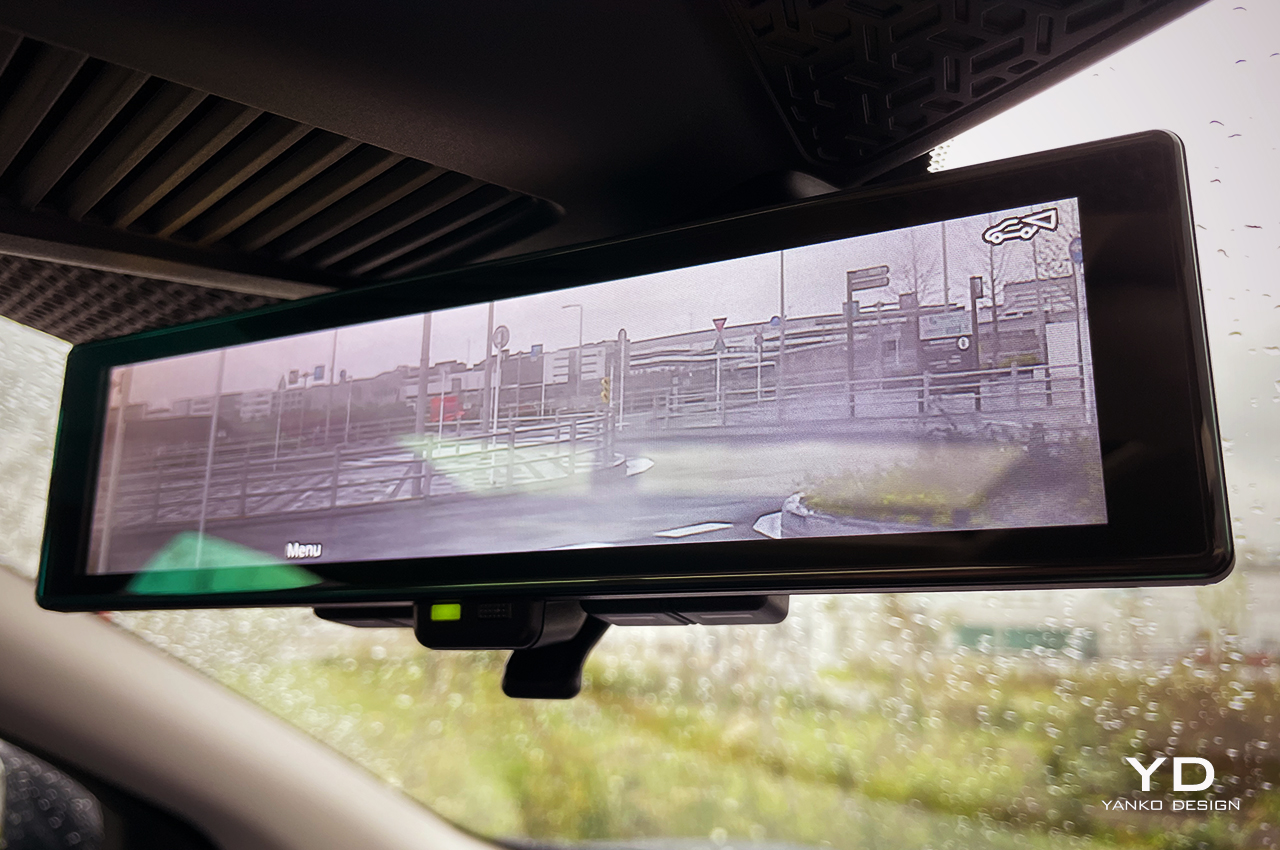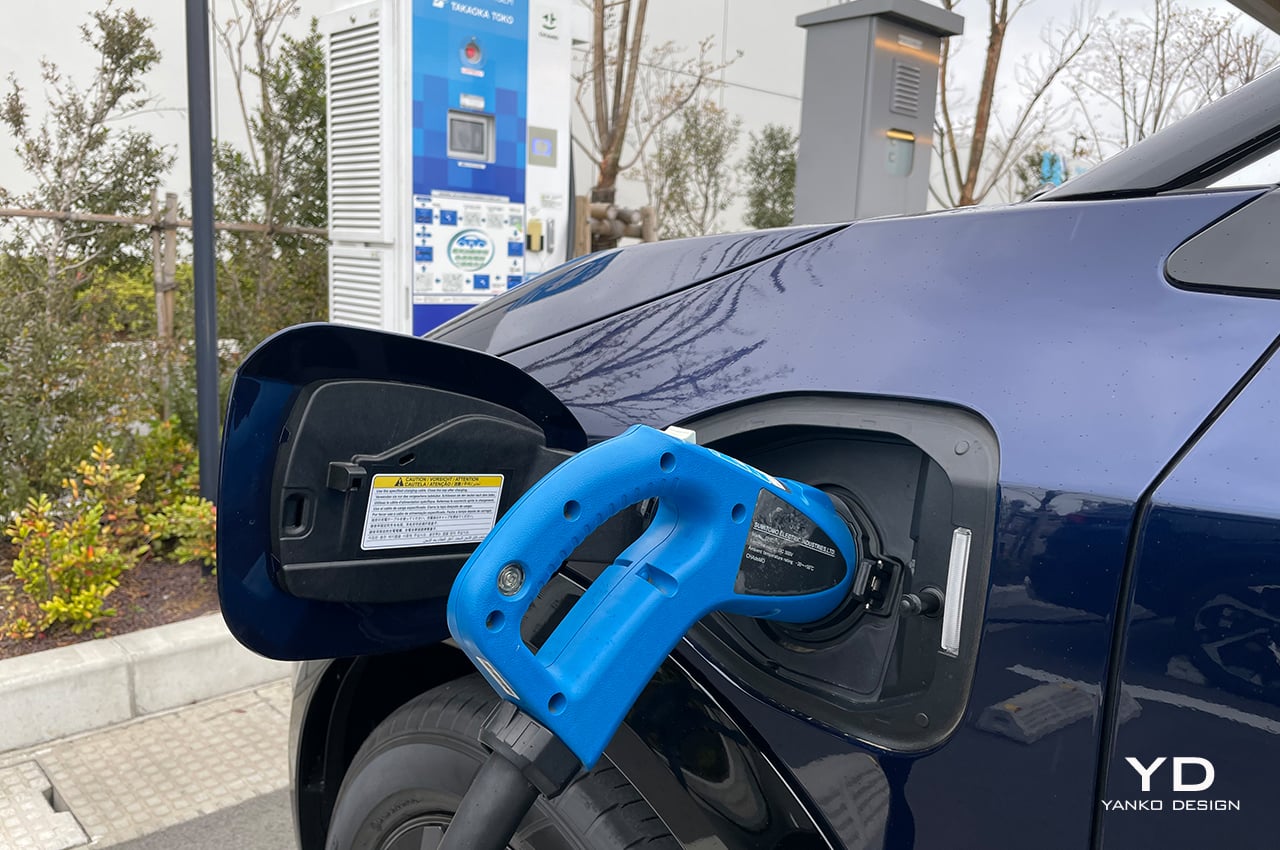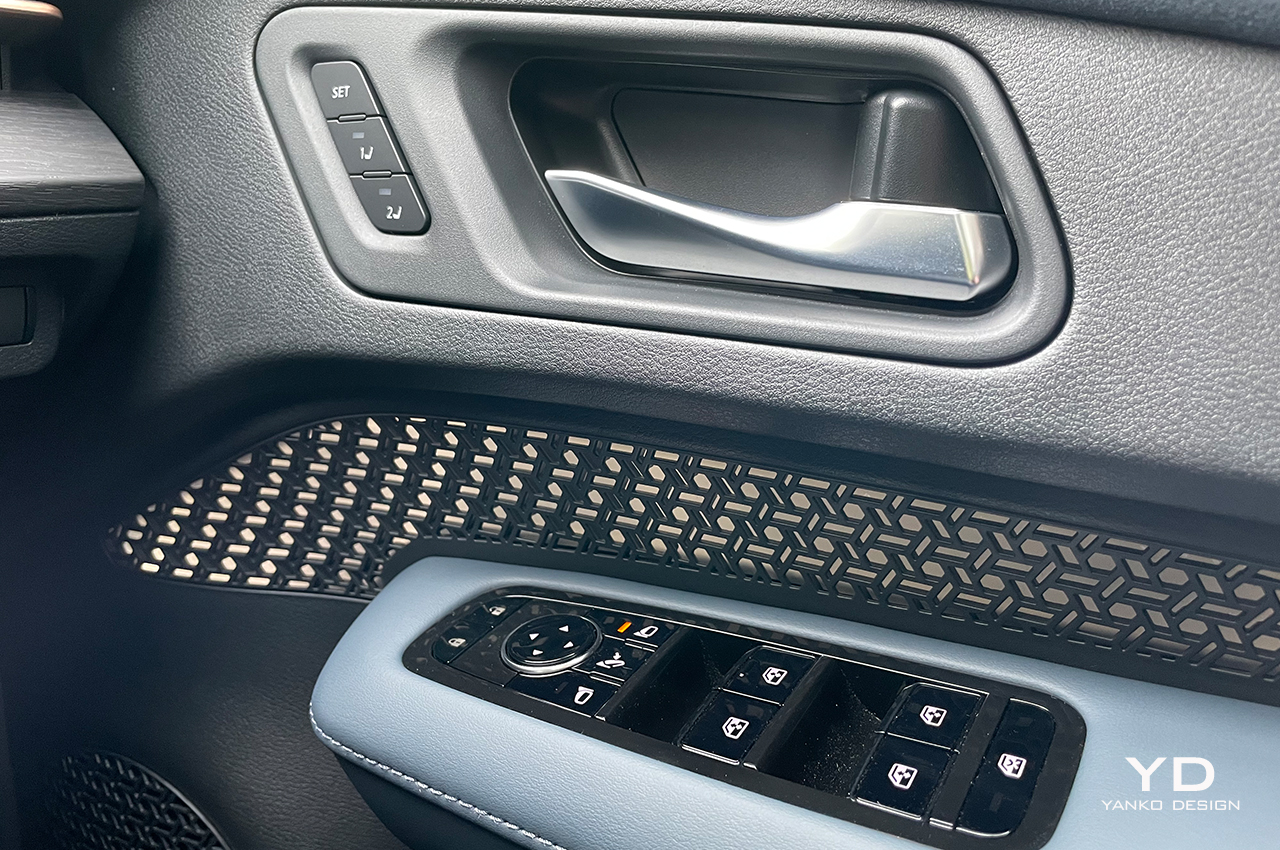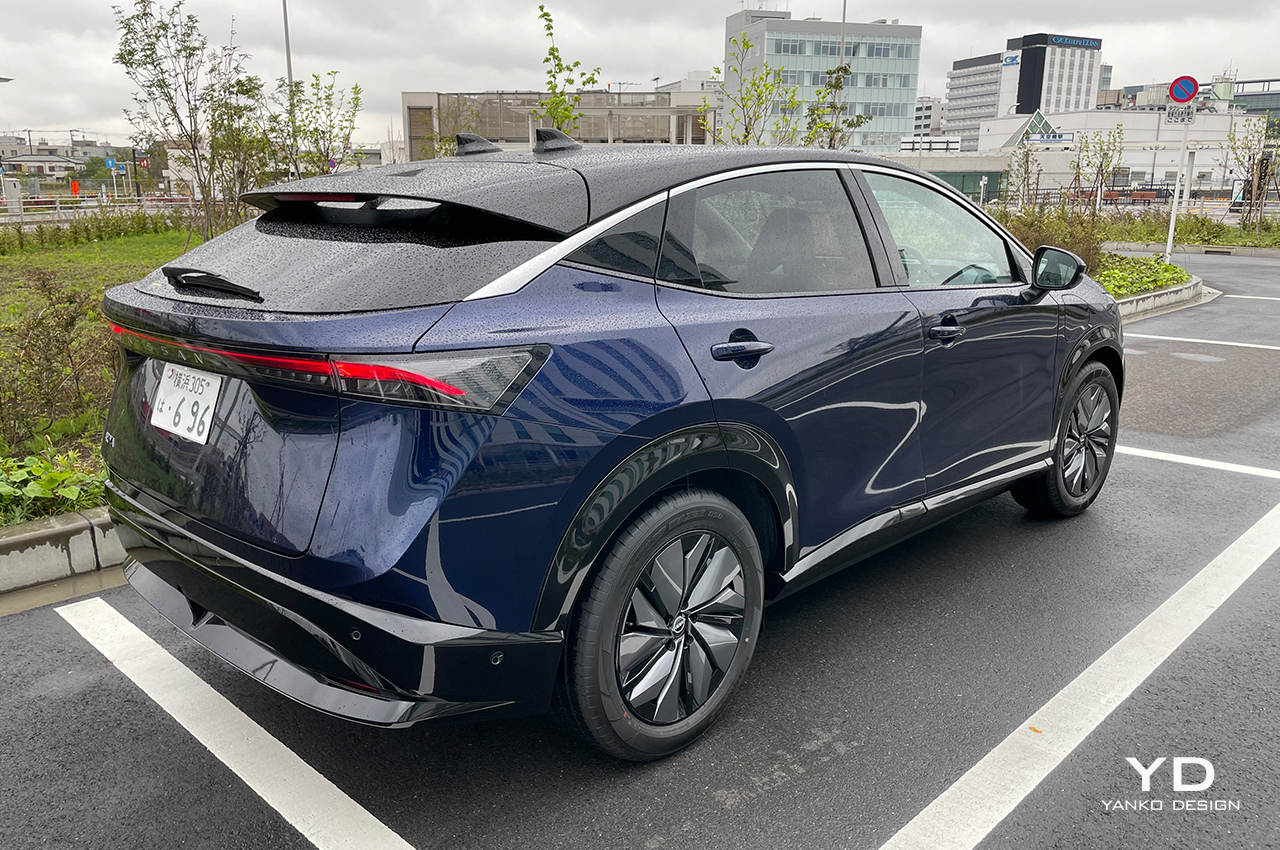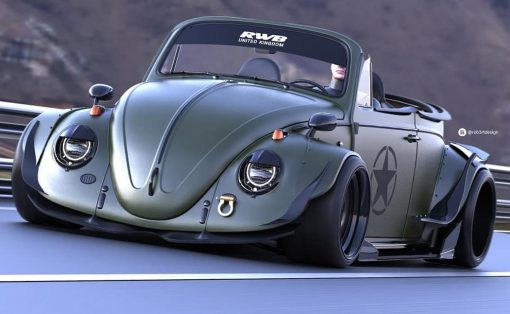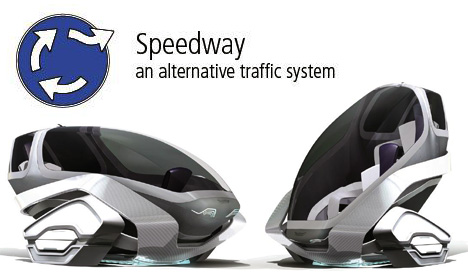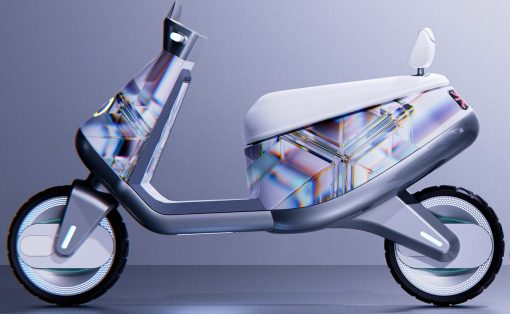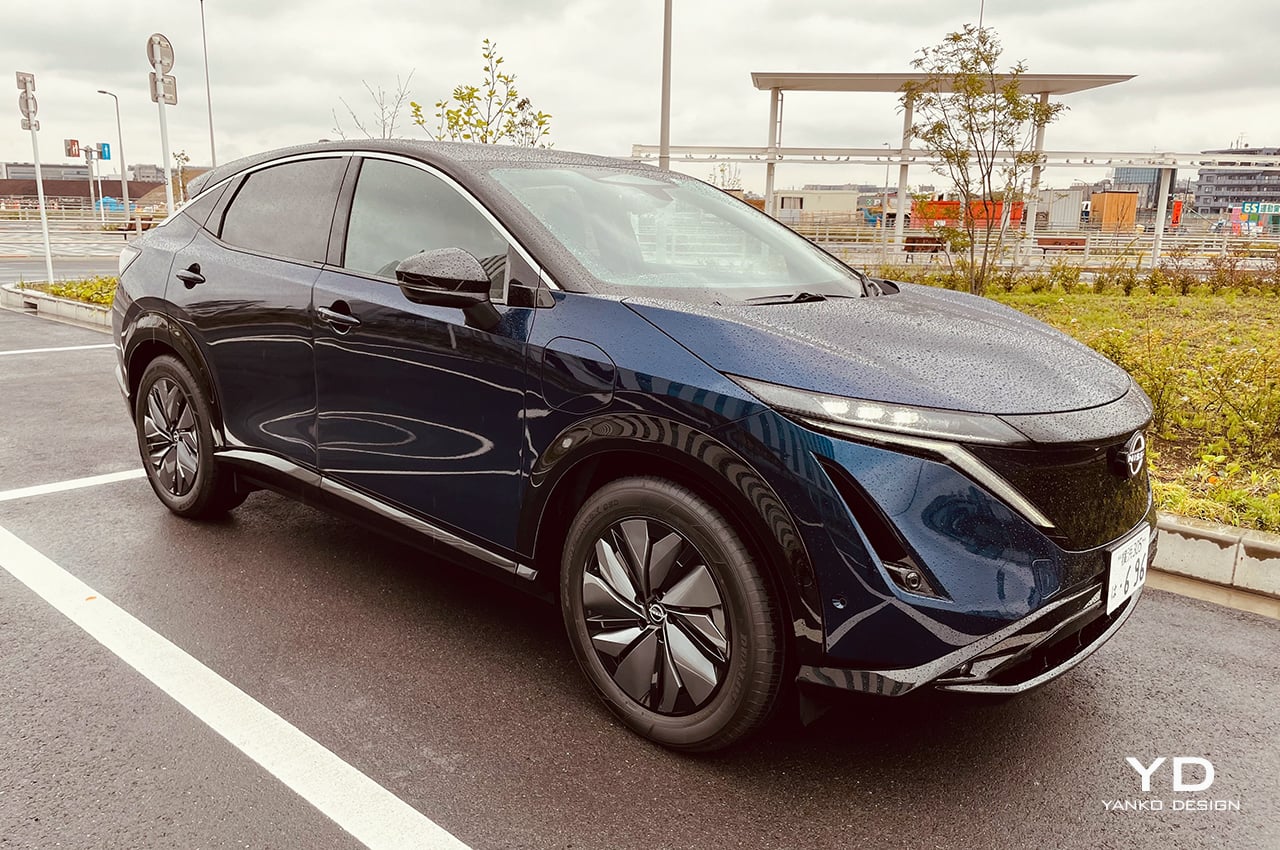
PROS:
- Stylish exterior and interior
- Powerful electric motor and great handling
- Well thought-out Amazon Alexa connection
CONS:
- Dash switches with haptic feedback take getting used to
- Rear windows don’t wind down completely
- No through loading from rear seat to luggage area
Nissan has a rich history of game-changing cars. The mighty GT-R (R35) supercar could jump from zero to 60mph in 3 seconds and initially offered 480 hp for under $80,000 when it first launched in 2007. A year before that, the hugely popular Qashqai SUV redefined Nissan as a brand in Europe and elsewhere. Then in 2010, the firm launched its multiple award-winning Leaf, the world’s first production electric vehicle, and in so doing, reinvented the EV market as we know it.
Ariya will do well against its rivals
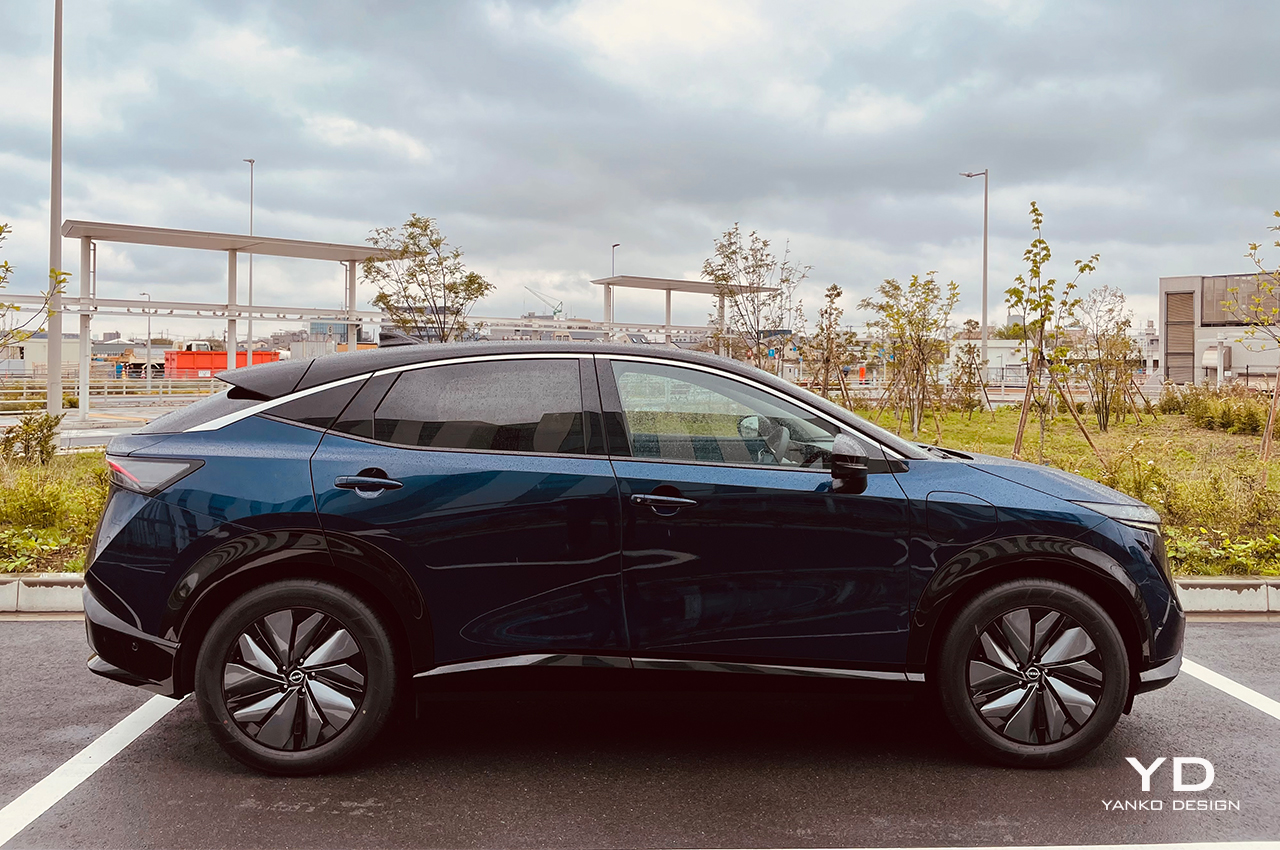
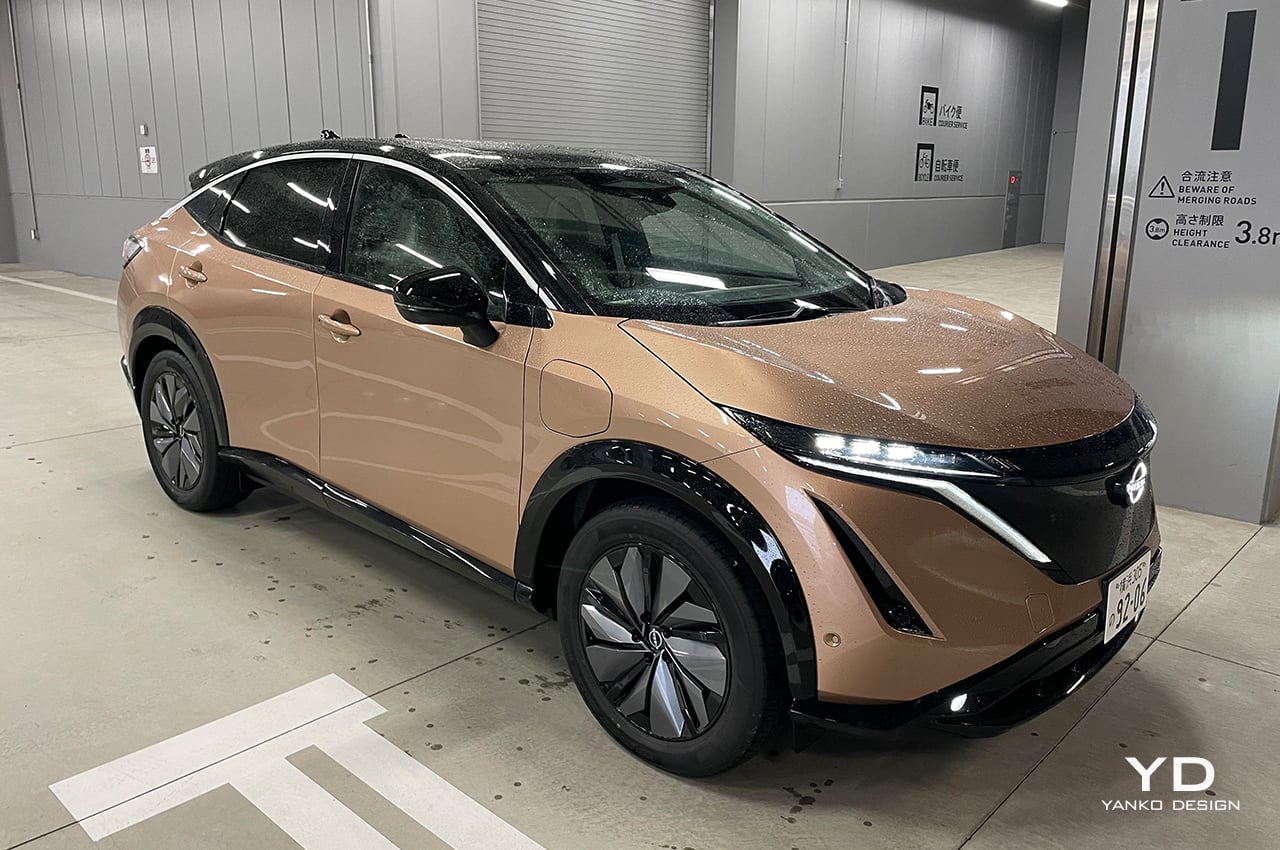
Now in 2022, the company will make another huge splash with its first-ever fully electric SUV, the all-new Ariya. And Yanko Design was one of the first to get behind the wheel of the 2-wheel drive version in Japan. It’s by far the most advanced car Nissan has ever made and will go head to head with the likes of the electric Tesla Model Y, Mustang Mach-E, BMW iX, Lexus RZ, and Audi e-tron. The question is: in an increasingly crowded market, does this EV have what it takes to catch the attention of potential buyers?
First impressions are very good. The Ariya looks well-proportioned, sporty, sharp, and unique. It is a huge leap forward from the Leaf. Its top version has a 91 kWh battery, a choice of two or four-wheel drive, has some innovative new tech, is great to drive, has a range of up to 310 miles, and boasts a starting price of around $47,000 for the two-wheel model.
Nissan’s design brief for this car was ‘Timeless Japanese Futurism’ which allowed the design team to tap into key Japanese words to inspire their global design team to create the Ariya’s exterior, words like sleek, sharp, and seamless. The overall design is definitely futuristic, but the most appealing part of its exterior for me is the front grille, which looks like a traditional grille but packs some stand-out features. Nissan instead calls their grille a ‘shield,’ as it shields hi-tech cameras, radar, and sensors that assist with the car’s self-driving system and ACC.
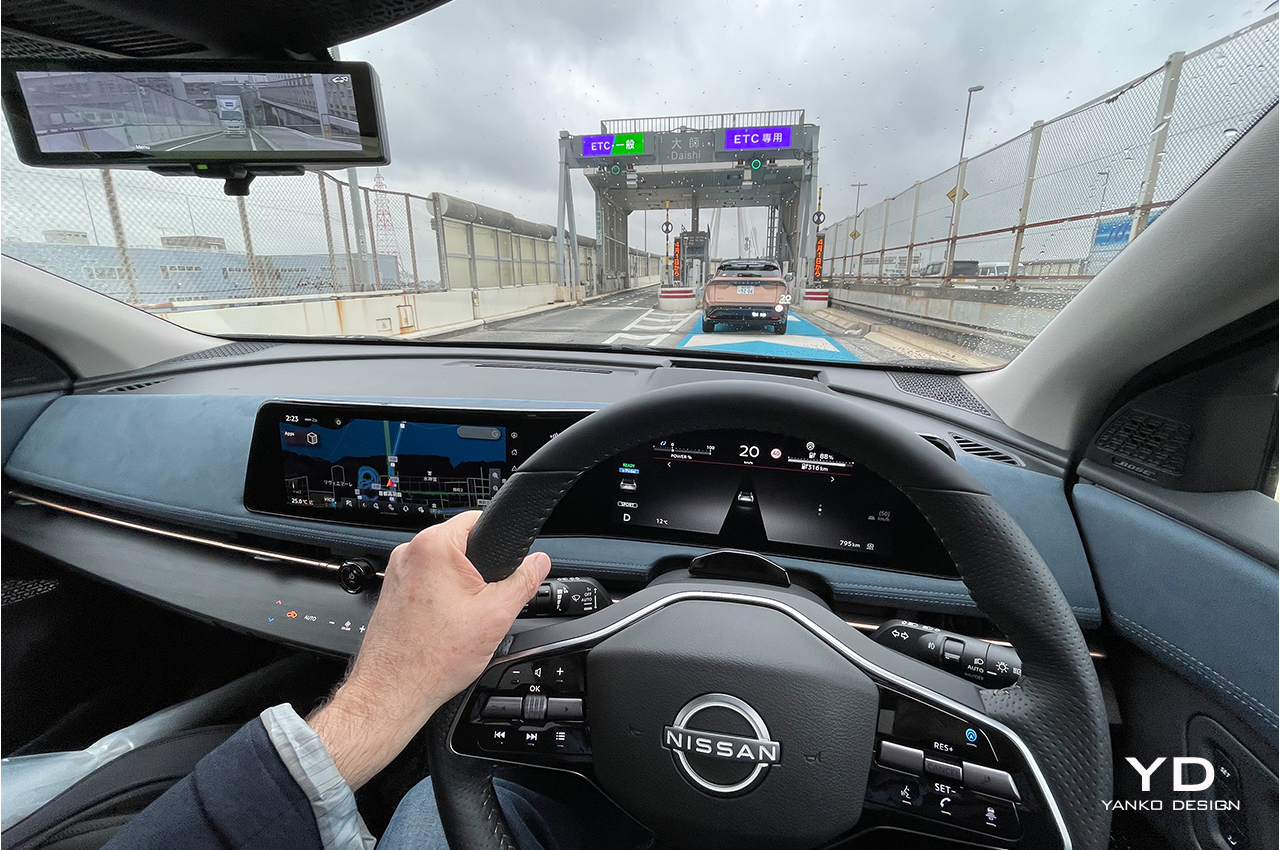
The grille is now called a ‘shield’ and for good reason
“By replacing a conventional grille with a hi-tech shield, that has an innovative 3D texture, we have given the Ariya the ability to read the road ahead and visualize things the driver cannot see, making what is invisible, visible,” says Alfonso Albaisa, senior vice president for global design.
The new front-end design features a new interpretation of the brand’s signature V-motion grille or shield, a shape that will appear on many of Nissan’s other new models to be rolled out in the next few years. It certainly looks bold, eye-catching and futuristic and helps to give the Ariya a definite identity in the sea of electric crossovers flooding the market. According to Albaisa, creating the new shield was a challenge for designers. They had to test the thickness of the material used, the amount of metallic flakes mixed in with the paint, and the shield’s pattern. The shield employs the same polycarbonate material found on the car’s headlamps but is transformed into a single piece using a traditional Japanese pattern.
Compared to its rivals, the Ariya’s sleek proportions are kind on the optic nerves. Viewed from the side, the car’s high beltline and sharp down-sloping rear end make this crossover look like a coupe that’s been dropped onto an SUV, but with panache. I especially like the rear end as well with its beautifully contoured tailgate and brake light bar that goes right across the back of the car. The new Nissan badging is catchy and the roof spoiler is as aesthetically appealing as it is aerodynamically efficient. Wheel arches are blacked out as are the side sill areas to give the car a sleeker profile and this SUV comes standard with 19-inch wheels. 20-inches are optional.
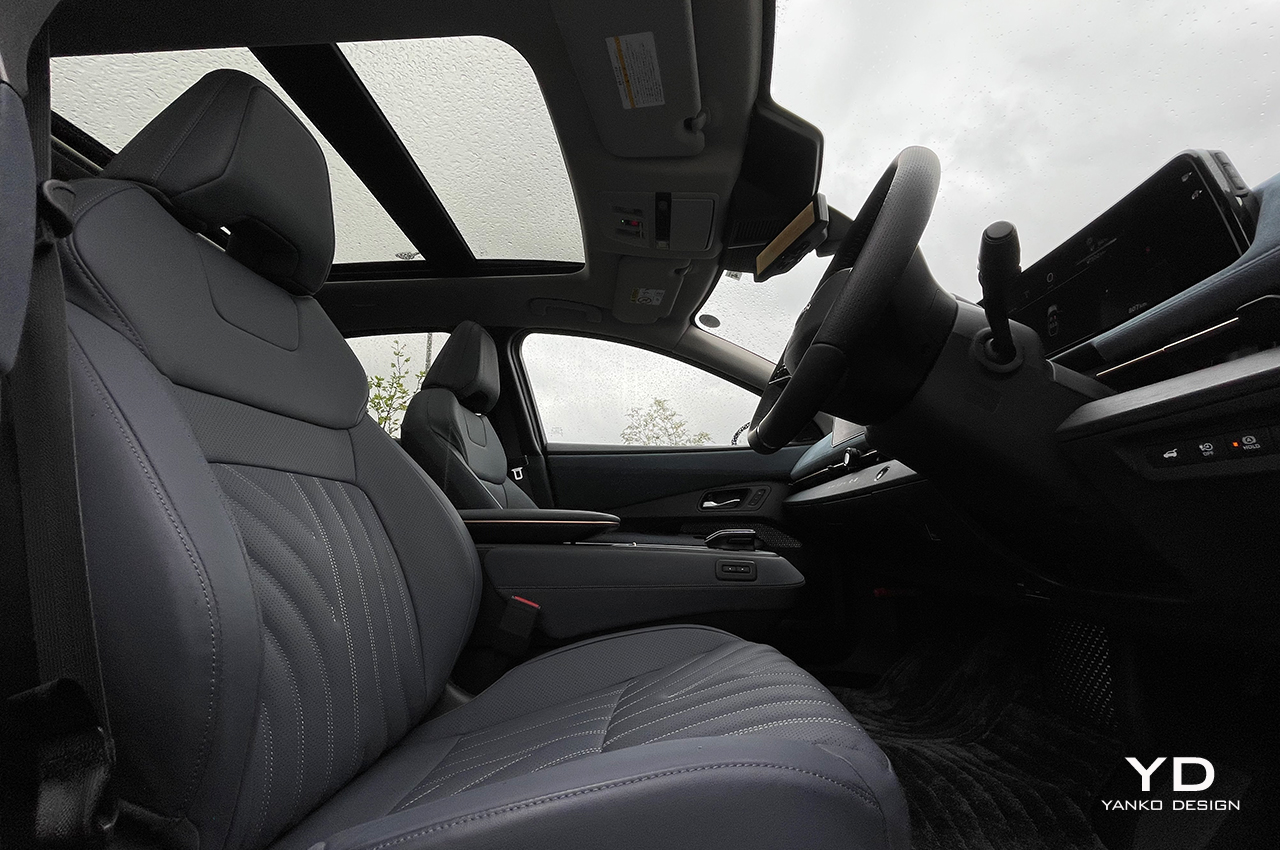
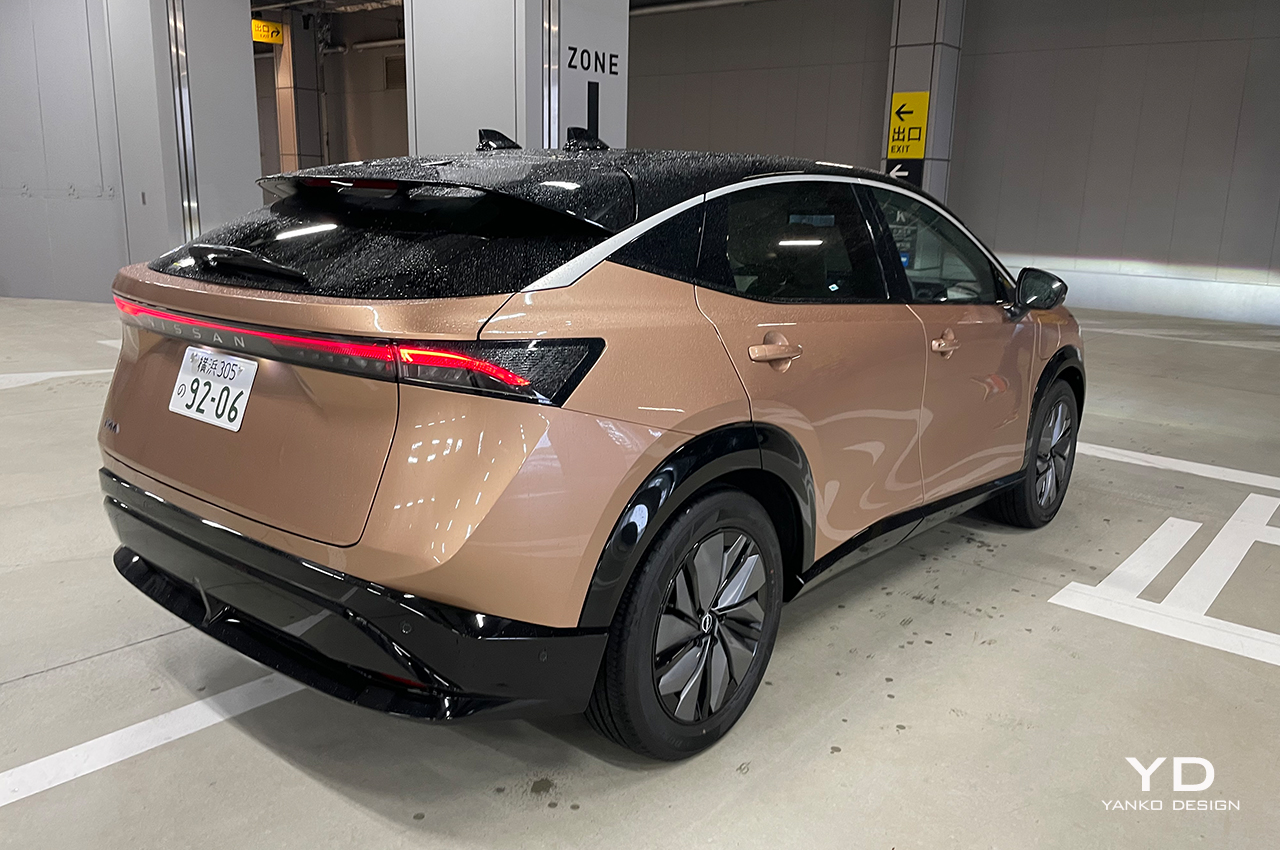
Its Amazon Alexa feature is revolutionary
On the inside, the Ariya is just as trendsetting. Nissan’s interiors are normally ho-hum at the best of times, but this SUV is on another level. It’s chic, stylish, futuristic and boasts some great new tech. Similar to the BMW iX, the Ariya gets a twin-spoke steering wheel, a large wraparound touchscreen that encompasses two large displays and switches and buttons with minimalist design. The air-con switches below the central touchscreen are actually built-in to the dashboard and offer haptic feedback when touched, but that touch needs to be practiced to get the quickest response. The cabin materials, including the Nappa seat leather and suede on the dash and doors feels posh and luxurious. Interestingly, if you don’t want to have animal skins in your car, you can opt for a vegan interior. But then again, it’s not fully vegan, because no matter what trim you choose, you will always get a full leather covered steering wheel.
One feature that really impressed was the new ‘NissanConnect’ collaboration with ‘Amazon Alexa.’ Using the Alexa function, Nissan drivers can use voice commands to unlock or lock their vehicle remotely, honk the horn, turn up the heat, choose a destination, flash the lights or stop the motor. But what was most satisfying was being able to ask Alexa, who boasts access to literally millions of songs, to play your favorite hit tunes. Within five seconds of asking the system to play Hotel California, the Eagles had already played the opening chords. It also offers a wireless smartphone charger, USB and USB-C ports, plenty of storage and ample cupholders. Pushing a button on the center console automatically releases an electrically-deployable tray that could hold a laptop if needed. Also, if you’re not quite happy with the position of the front center armrest, you can easily shift it forward or backward just by pushing a switch on the side of the armrest.
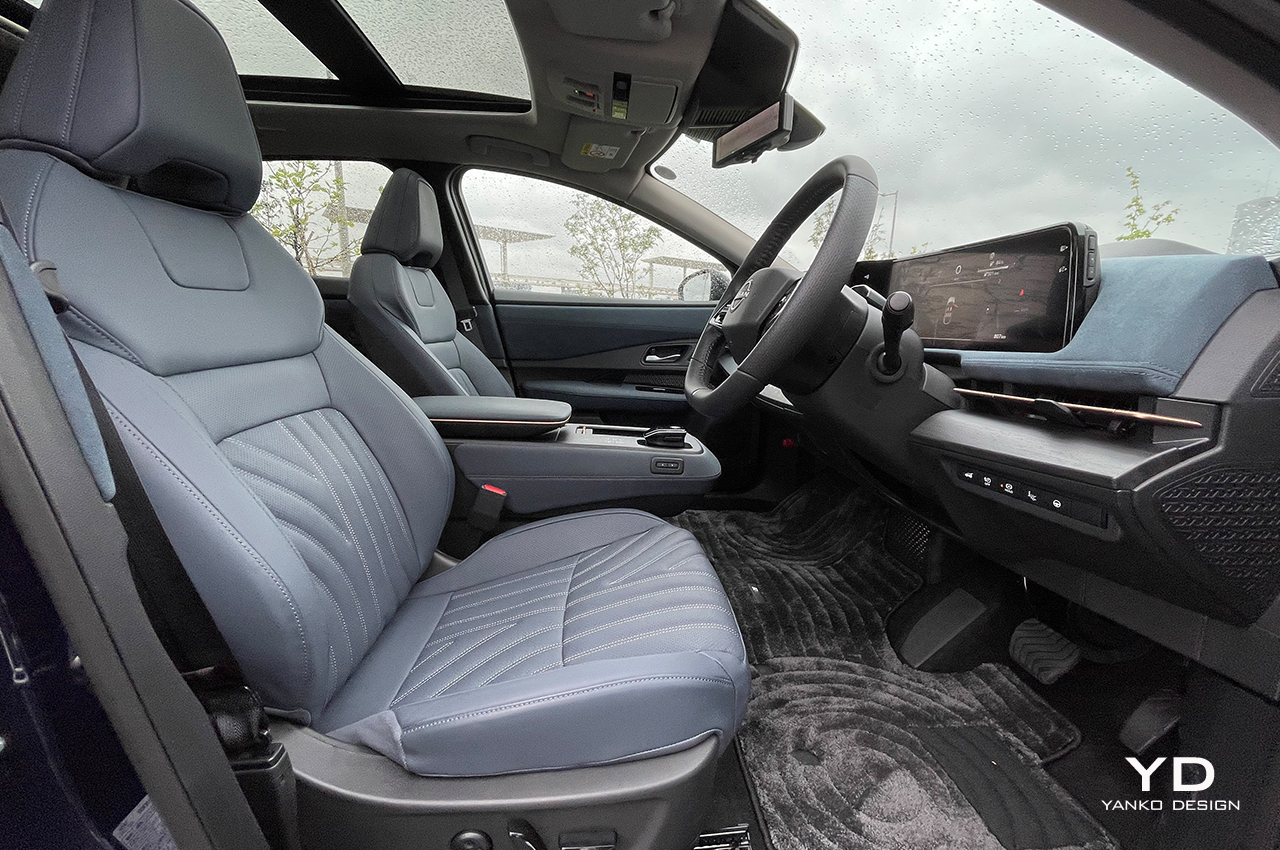
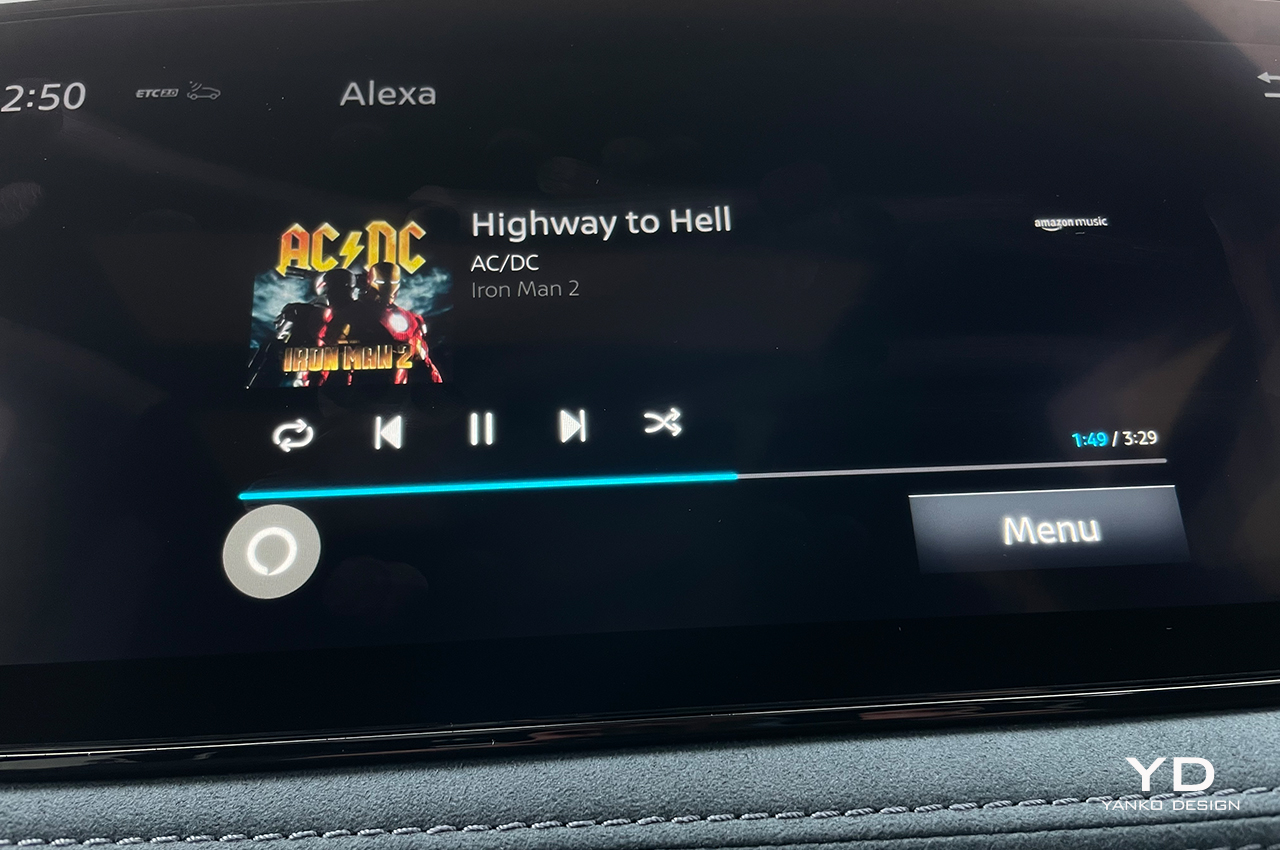
Albaisa says that Nissan wanted to redefine the full driving experience, from approaching the vehicle to operating it, living with it and interacting with its new features. “With Ariya, we considered the meaning of omotenashi (meaning high level of hospitality) in the modern digital context. For example, when a driver walks up to the car, the Ariya seems to be welcoming you as it lights up it 20 LED lights inside the large grille logo together with the boomerang-styled daylight running lights. As the driver enters the car, all icons are blacked out, only the start button is pulsating waiting for the driver to engage the electric motor. When the button is pushed, all icons a switches gently come to life, including the colorful startup sequence on the graphic user interface.
The decision to stretch the wheelbase has paid off because the rear seats are roomy and conformable and can cater to three adults. Even with its huge battery pack under the floor, the low flat floor ensures the Ariya offers plenty of leg and headroom, and even with the panoramic sunroof, headroom is still acceptable. In the back you also get heated rear seats and USB ports but for whatever reason, the rear windows do not wind down completely, a sore point for some buyers. One other pet peeve some buyers may have is the fact that this car has no through loading from the rear seat to the luggage area, so you cannot push your snowboard or skis though the center armrest. Generating 466 liters of luggage space, the Ariya is just acceptable for a large SUV, especially when you compare the slightly smaller Volkswagen ID.4’s 543 liters. On the plus side, the Ariya has a special hidden compartment under the rear floor to store the luggage cover, a feature that many other SUVs forget.
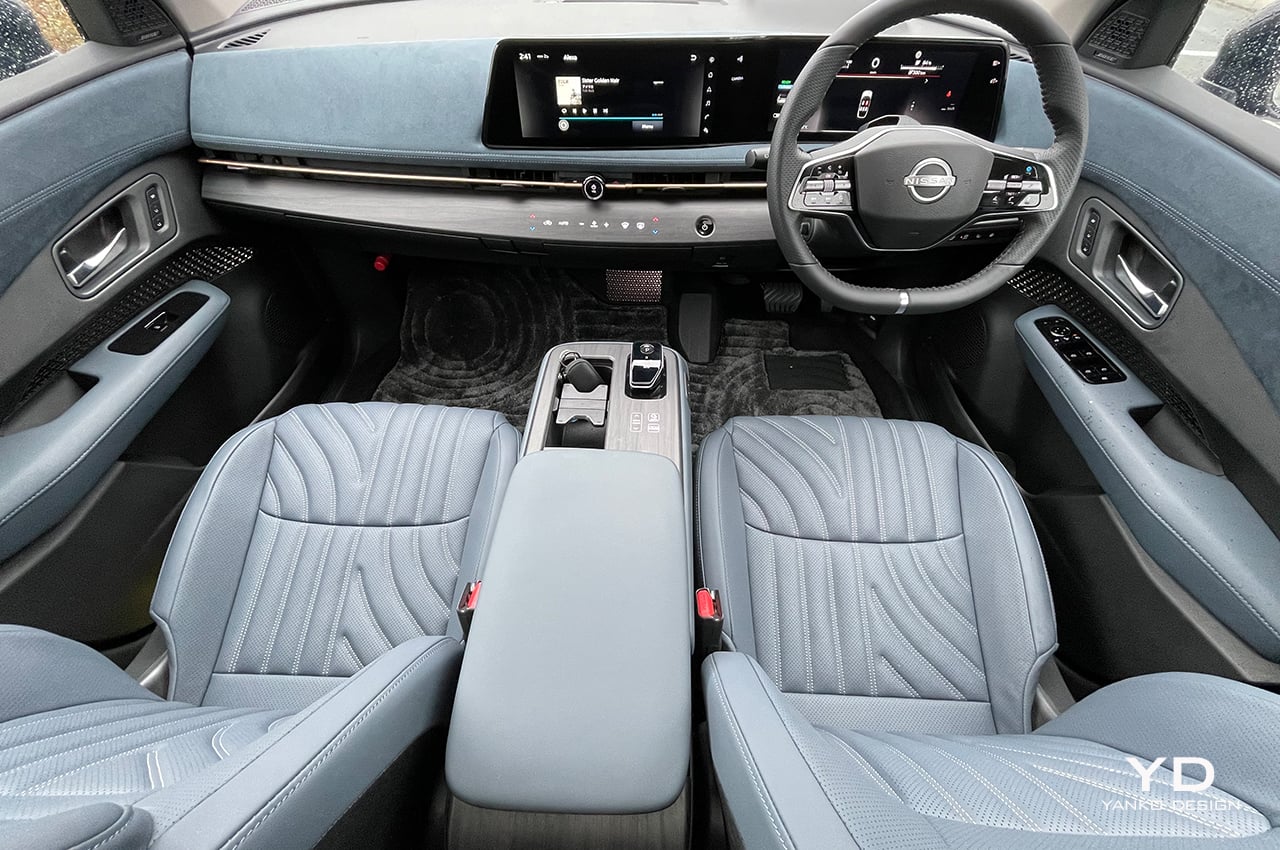
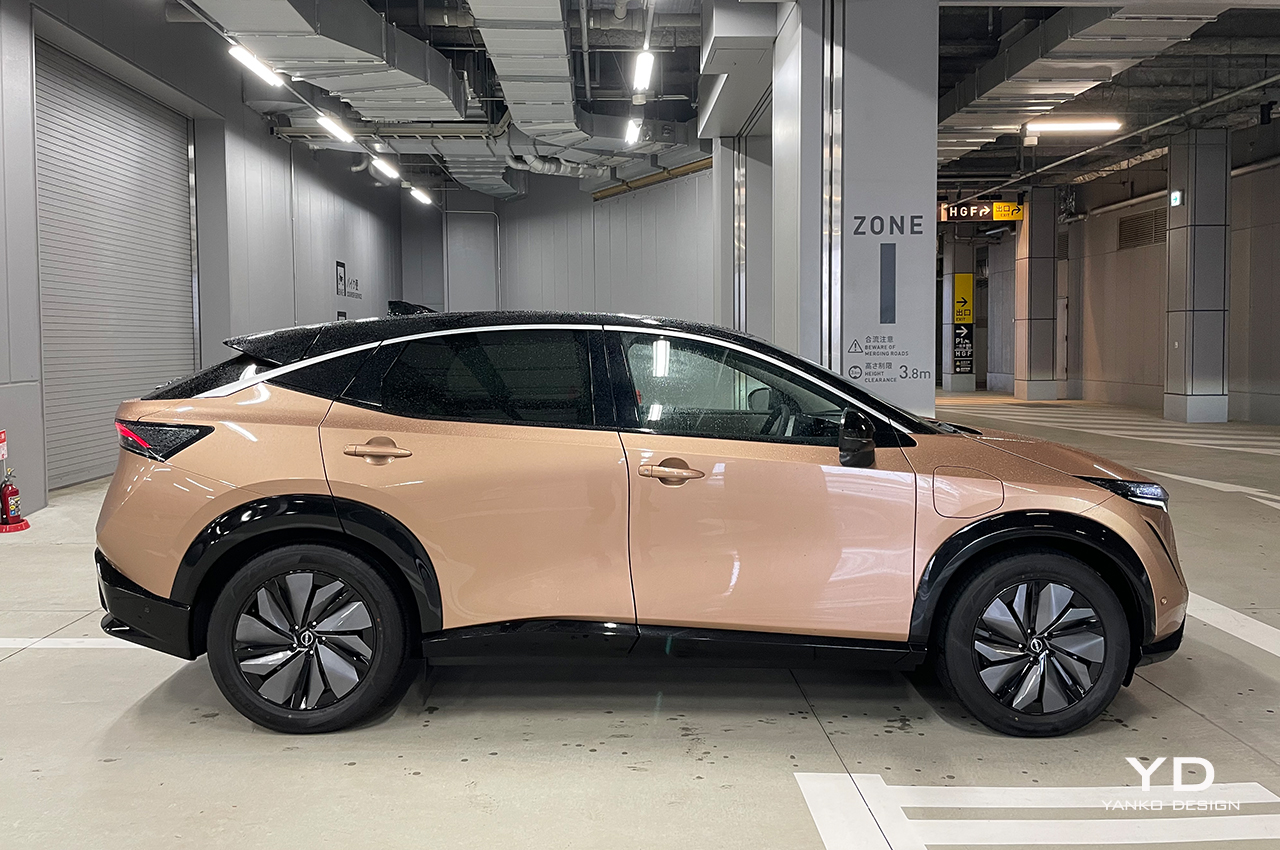
The 2WD version will be followed by a more powerful 4WD model
Our test vehicle was the entry level ‘B6 limited’ model with 2 wheel drive and a 66 kWh battery pack that allows the car the accelerate from zero to 60 mph in 7.4 seconds. For EVs, this is by no means a quick acceleration time but is perfectly acceptable for a large electric SUV. However, the smaller battery pack does help keep the price down to around $47,000 in the U.S. or 5.4 million yen in Japan. Other versions including the 2 wheel drive ‘B9 limited’ version with the 91 kWh battery that will launch later this year with a gutsy 394-hp. The ‘B6 e-4orce’ (pronounced ‘e-force’) 4-wheel drive (66kWh) and the ‘B9 e-4orce’ 4WD model coming after that. In comparison to the B6’s sub-8 second 0-60 time, the more powerful B9 model is expected to sprint from 0-60 mph in around 5 seconds. That will make the Ariya as quick as a new 400-hp Nissan Z.
According to the global WLTP rating standard, our front wheel drive B6 limited with its 66 kWh battery pack has a range of 470 km in Japan or 300 miles in the U.S. The motor generates 218 hp and offers quick charging at a 50kW charger in 65 minutes or 45 minutes at a 90kW quick charger. Meanwhile, the 91 kWh models will develop upwards of 394-hp
Behind the wheel, the Ariya is a nice place to be. Your leather seats are supportive and comfortable and the expansive touchscreens provide all the information you’ll need to drive or entertain yourself. The drive selector lever moves forward and backward on the center armrest while the drive mode switches, embedded into the console panel provide instant haptic feedback, but do take some getting used to.
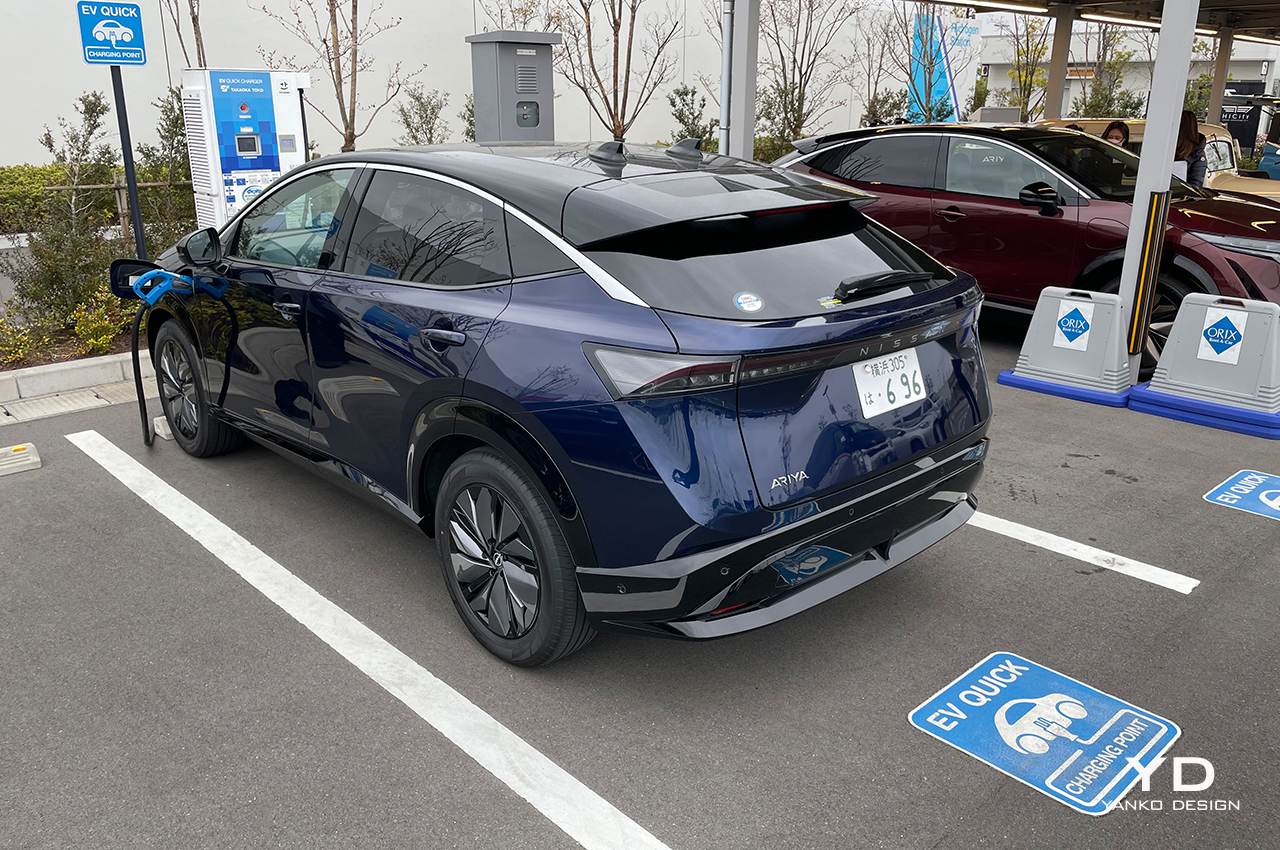
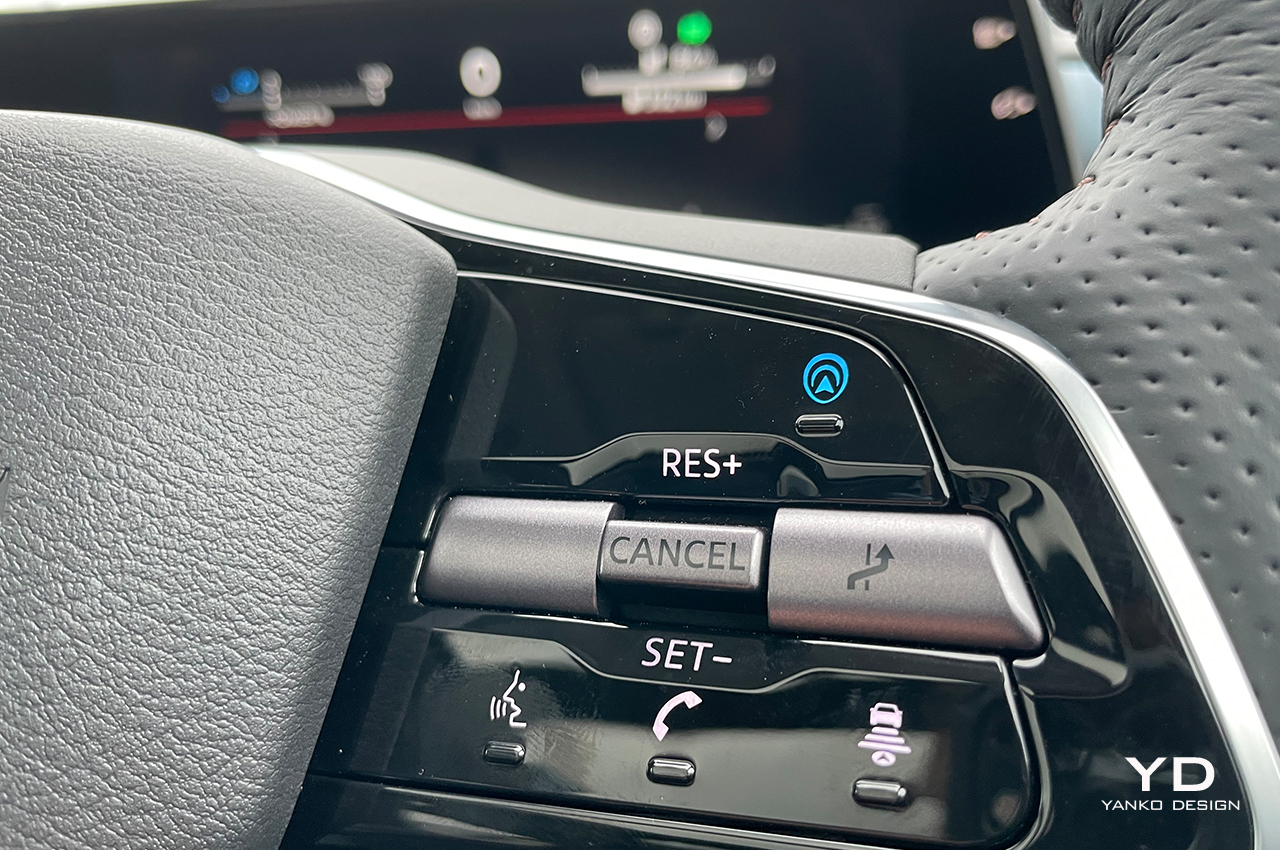
Low center of gravity resists rolling in the corners
As you’d expect the Ariya accelerates smoothly and effortlessly with enough power to move and merge seamlessly in traffic around town or cruise on a highway. Its ride is firm and sporty and resists rolling in the corners thanks to its floor-mounted battery packs and resulting low center of gravity. The steering is light and responsive with plenty of feedback coming through from the front wheels. On a twisty road the 1960-kg heavy Ariya performed surprisingly well and handled weight transfer with ease. Brake feel is also grippy while offering a natural
One thing you can’t complain about is the visibility. The low set dashboard and large windscreen provide the driver with an uninterrupted view ahead although the thickish crash-absorbing A-pillars are reminiscent of those found in many large SUVs today. The view out of the rearview mirror is not great thanks to the sloping roof and rear headrests which is why Nissan offer an optional rear-mounted camera that shows drivers exactly what’s happening behind the car. The rear pillar however does create a blindspot which means drivers must adapt by correctly setting their side mirrors and using that fancy rear camera.
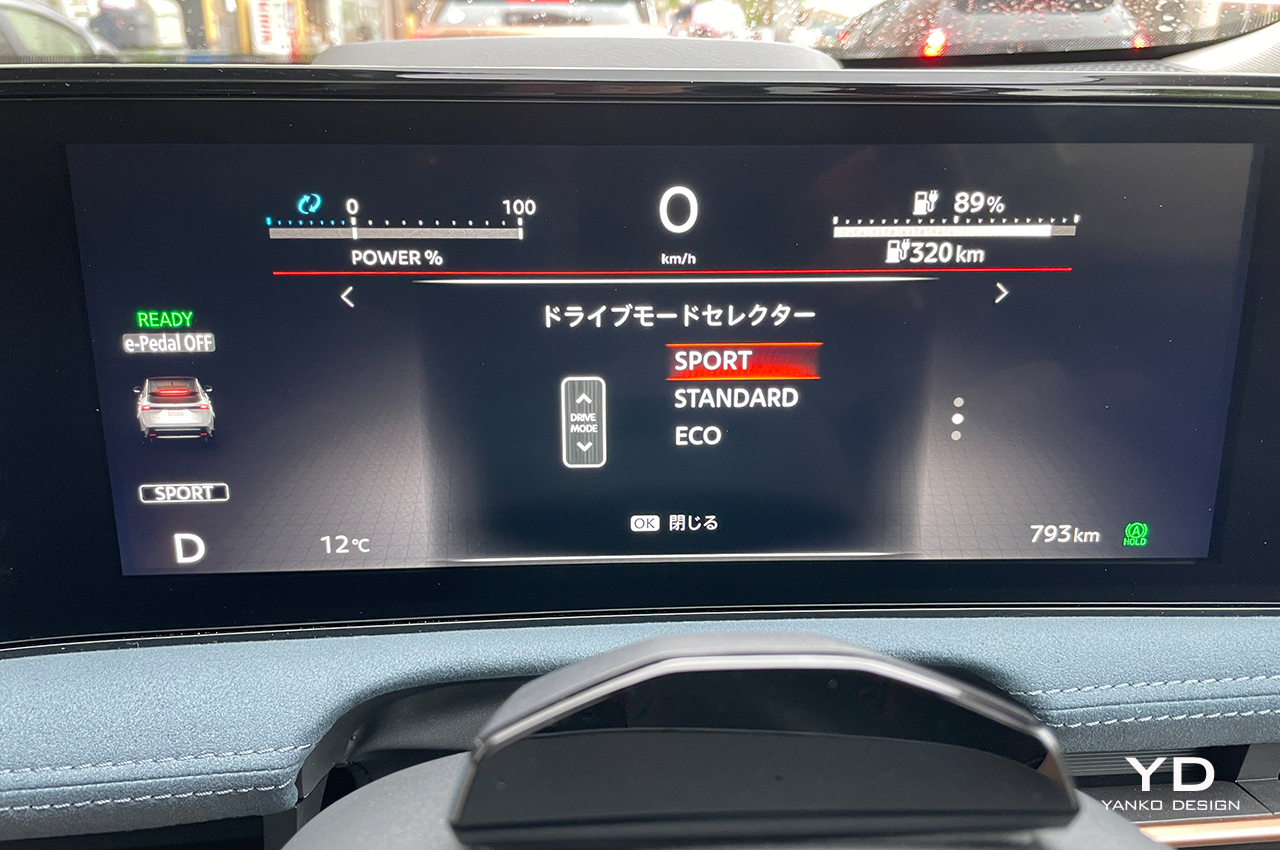
The first thing I did when I merged into heavy traffic on the expressway near Tokyo was to set the Ariya’s Pro-Pilot cruise control to 70-mph. This engages steering assist and lane assist which means the car will not only accelerate and brake automatically depending on vehicle movements ahead, but it will also follow corners automatically. As it is the system works effortlessly and smoothly. But actually, the Ariya packs radar, camera, and sensor technology that will allow it to elevate to Level 3 driving when the law allows it.
The e-pedal is a special Nissan feature that allows drivers to cruise using just one pedal — the throttle. Accelerate in e-pedal function and the car will speed up, obviously, but ease up on the throttle and the car will automatically brake, and quite aggressively. This so-called regenerative braking helps to recharge the batteries while decelerating but does take some practice to brake smoothly in unison with traffic around you. For some reason, however, Nissan has removed the stop function so the car will always creep along, even when set to its most aggressive e-pedal region brake mode. That according to Nissan is to keep drivers alert, and it makes sense.
As you’d expect in an EV, the cabin is eerily quiet meaning that the only sounds you hear are some road or wind noise or Deep Purple’s ‘Highway Star’ on the Bose sound system that you’ve requested from Alexa.
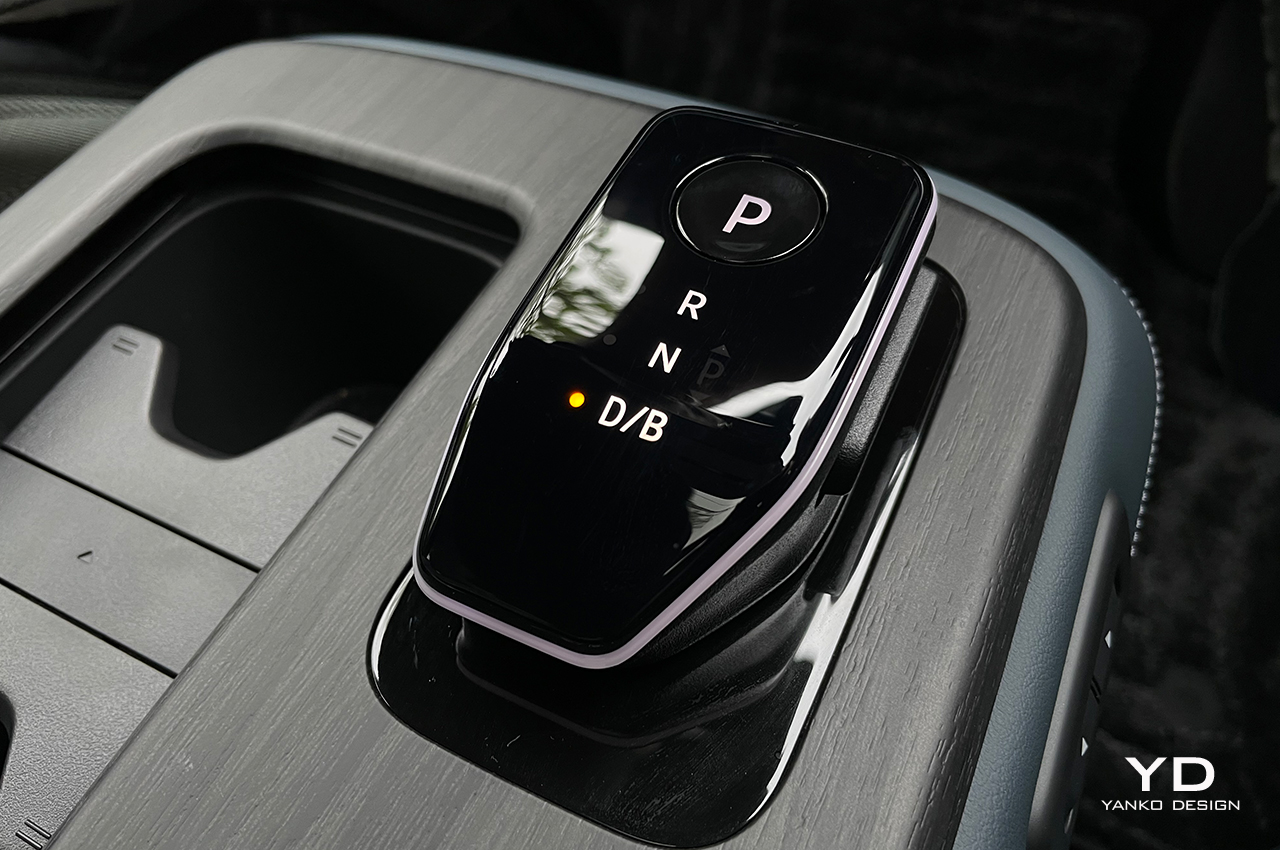
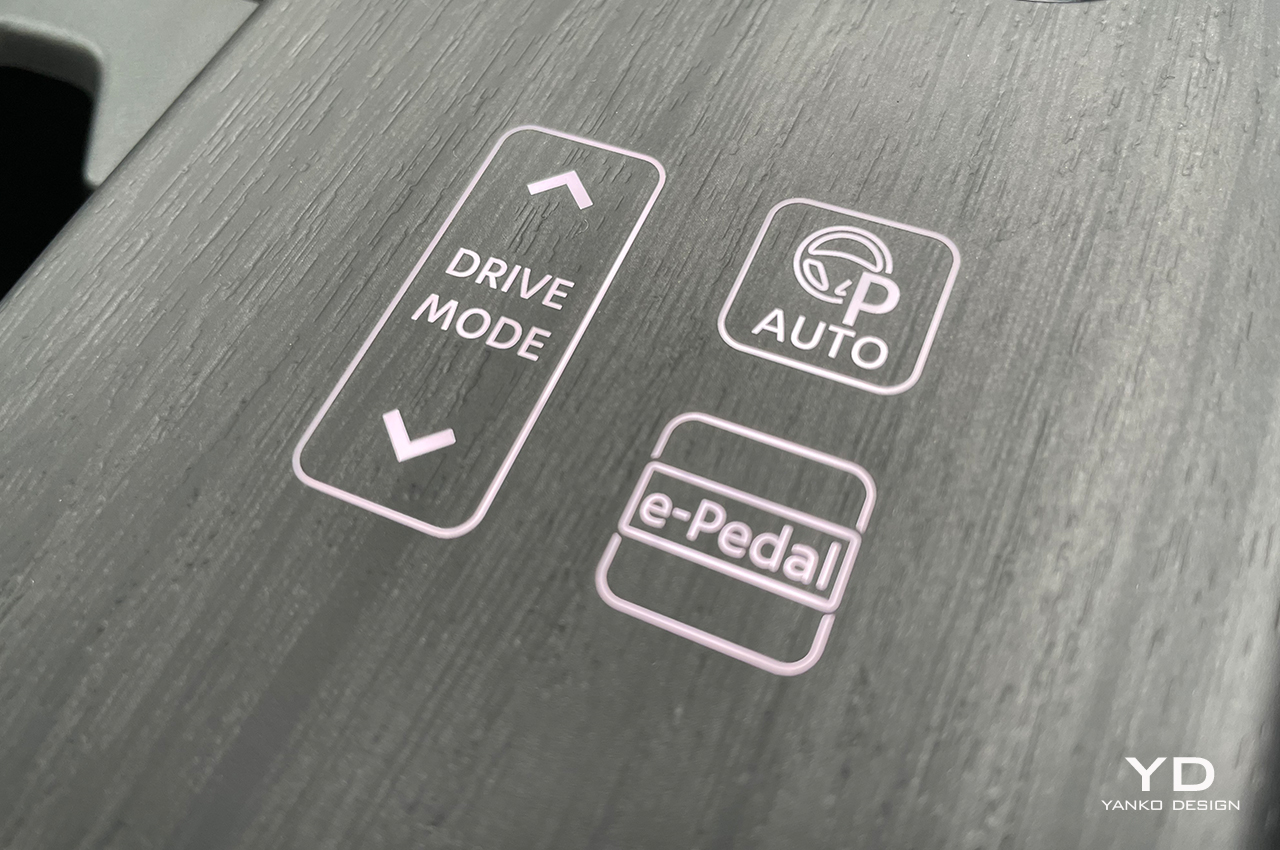
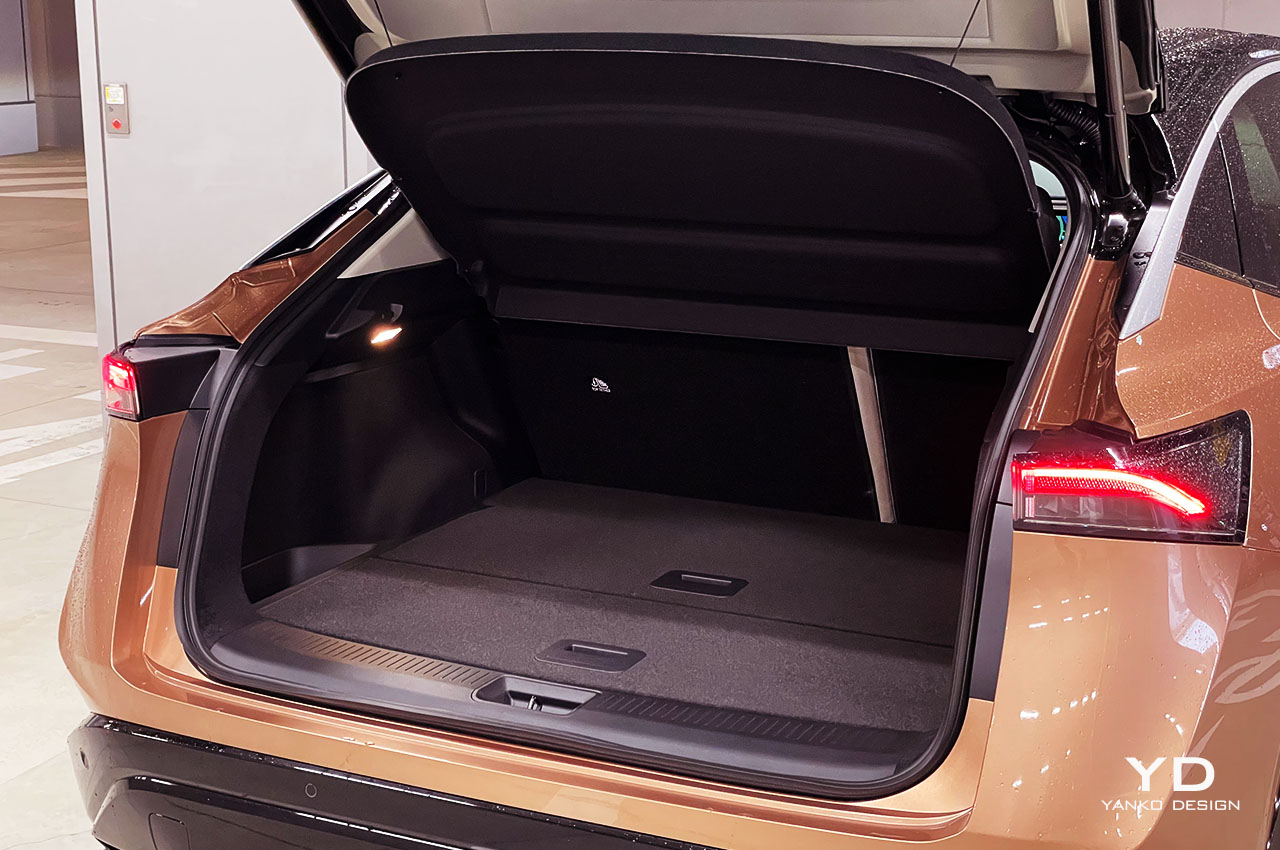
Prices and Options
As we’ve mentioned above, the Ariya will be available in 4 different versions starting at around $47,000 for the 66 kWh 2-wheel drive B6 limited model. Prices for upcoming models are still sketchy but expect the fully specced 91 kWh 4WD B9 limited model to hover at around $55,000.
Owners can choose from 9 body colors including red, blue, light silver, gunmetal grey, copper, and white as well as mix and match with the same color or black roofs. Inside, buyers can choose from a selection of the entry-level black suede and faux leather or Nappa leather in black, grey, or blue-grey.
